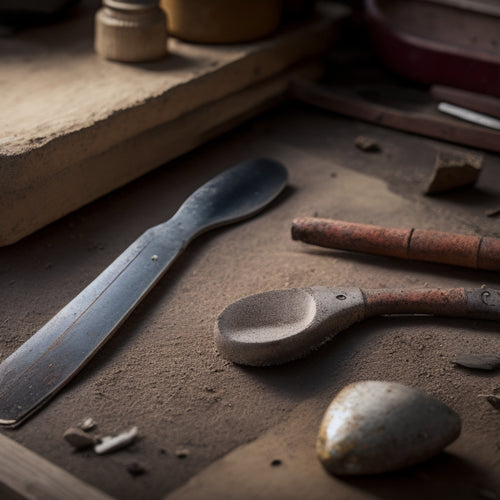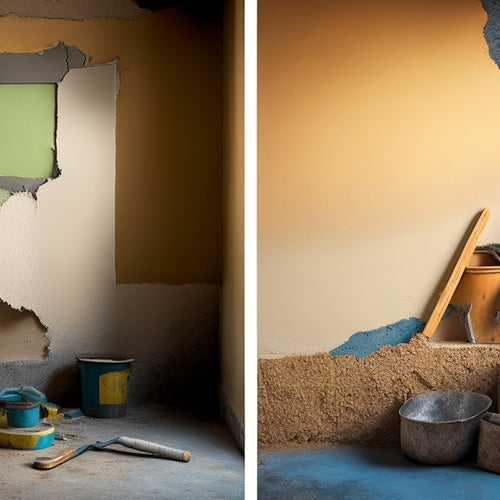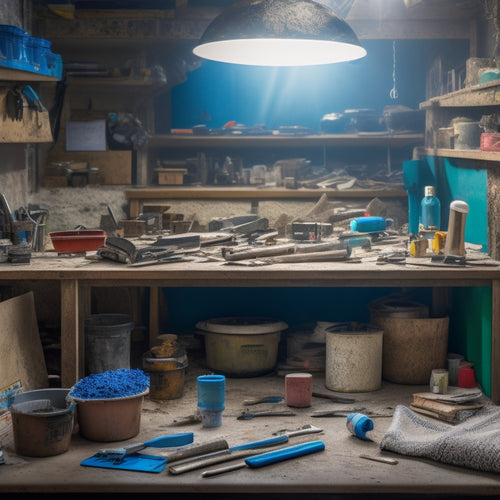
10 Must-Have Tools for Safe Floor Renovation
Share
When tackling a floor renovation project, you'll need a robust set of tools and equipment to guarantee a safe and successful outcome. From personal protective gear like hard hats, respirators, and steel-toed boots, to dust management systems featuring HEPA-filter vacuums and air quality monitoring, every component plays a critical role. You'll also require heavy-duty cleaning and scraping equipment, such as floor scrubbing machines and industrial vacuum cleaners, as well as cement mixing and pouring tools, safety netting, and fall protection systems. By investing in these must-have tools, you'll be well-prepared to tackle your project with confidence, and uncover the secrets to a hazard-free renovation.
Key Takeaways
- Wear personal protective gear, including hard hats, safety goggles, respirators, and steel-toed boots to prevent injury and exposure to hazards.
- Implement dust control methods, such as barriers and dustless scraping systems, to minimize airborne particles and prevent respiratory issues.
- Utilize heavy-duty cleaning and scraping equipment, like floor scrubbing machines and industrial vacuum cleaners, to efficiently remove debris and dust.
- Ensure a safe working environment by monitoring air quality, using HEPA filter vacuums, and adjusting dust control methods accordingly.
- Install safety netting and fall protection systems, and conduct regular safety inspections to prevent falls and ensure a secure working environment.
Personal Protective Gear Essentials
At least six personal protective gear essentials should be part of your arsenal when undertaking a floor renovation project.
You'll need head protection, such as a hard hat or safety helmet, to shield your skull from falling debris, tools, or building materials.
A face shield or safety goggles will provide eye protection from dust, flying particles, and chemical splashes.
Don't forget respirators or dust masks to filter out hazardous airborne particles and prevent respiratory issues.
Steel-toed boots or safety shoes with slip-resistant soles are a must-have to protect your feet from heavy objects and slippery surfaces.
You'll also need earplugs or earmuffs to prevent hearing damage from loud power tools and machinery.
Finally, gloves with grip and puncture resistance will safeguard your hands from cuts, abrasions, and crushing injuries.
Dust Containment System Requirements
Controlling dust and debris is critical to a successful floor renovation project, and a dust containment system is essential to achieving this goal.
You must prioritize dust control methods to prevent airborne particles from spreading throughout the site and compromising air quality. A thorough dust containment system should include a combination of barriers, vacuums, and air quality monitoring tools.
Set up barriers to isolate the renovation area from the rest of the space, using materials like plastic sheets or tarps to contain dust and debris.
Next, invest in a high-powered vacuum with a HEPA filter to capture 99.97% of particles as small as 0.3 microns. This will help minimize airborne dust and prevent it from spreading to other areas.
To guarantee the system is working effectively, you'll need to monitor air quality regularly.
Use air quality monitoring devices to track particulate matter, relative humidity, and temperature levels. This data will help you adjust your dust control methods and containment system as needed to maintain a safe and healthy working environment.
Heavy-Duty Cleaning Equipment
You'll need heavy-duty cleaning equipment to effectively remove dirt, grime, and old adhesives from your floor.
Floor scrubbing machines, equipped with rotating brushes and water tanks, are ideal for tackling large, stubborn stains.
Industrial vacuum cleaners, with their high-capacity dust collection and powerful suction, will help you efficiently remove debris and dust from the renovation area.
Floor Scrubbing Machines
With floor renovation comes the challenging task of removing old adhesives, dirt, and grime that have built up over time, which is where heavy-duty floor scrubbing machines come into play.
These powerful tools are designed to tackle the toughest cleaning jobs, making them an essential investment for any floor renovation project. When choosing a floor scrubbing machine, consider the type of floor you're working with and the level of cleaning required.
Look for machines with adjustable speed controls and rotating brushes for maximum efficiency. Additionally, consider eco-friendly options that use less water and energy, making them a more sustainable choice for your project.
To get the most out of your floor scrubbing machine, follow these floor maintenance tips: always pre-sweep the floor to remove debris, use the correct cleaning solution for the type of floor, and change the brushes regularly to maintain effectiveness.
Industrial Vacuum Cleaners
Industrial vacuum cleaners are an important component of heavy-duty cleaning equipment, designed to tackle the most demanding tasks in floor renovation projects.
You'll need a vacuum that can handle the heavy dust and debris generated during renovation, and industrial vacuums fit the bill. These powerful machines are equipped with industrial filtration systems, which capture 99.97% of dust particles as small as 0.3 microns, guaranteeing a clean and safe working environment.
When selecting an industrial vacuum, consider the size of the renovation area and the type of debris you'll be dealing with. Look for vacuums with high CFM (cubic feet per minute) ratings and water lift capabilities to promote efficient cleaning.
Regular vacuum maintenance is also vital to extend the lifespan of your equipment and prevent downtime. Make sure to check and replace filters regularly, and clean the vacuum's pre-filters to maintain peak performance.
With the right industrial vacuum cleaner, you'll be able to tackle even the toughest floor renovation projects with ease and confidence.
Advanced Floor Scraping Tools
When you're tackling a floor renovation project, you'll need advanced floor scraping tools that can efficiently remove old adhesives, coatings, and flooring materials.
You should opt for heavy-duty scraping blades that can withstand the rigors of scraping concrete, hardwood, or tile floors. Additionally, look for tools with adjustable handle angles and dustless scraping systems to minimize fatigue and mess.
Heavy-Duty Scraping Blades
Tackle old flooring with confidence by equipping yourself with heavy-duty scraping blades, the ultimate game-changers in advanced floor scraping tools. These blades are designed to tackle the toughest flooring projects, and their durability guarantees they'll withstand the rigors of heavy use.
When selecting a heavy-duty scraping blade, consider the blade material type and its suitability for your project. The following table highlights popular blade material types and their characteristics:
| Blade Material | Characteristics | Scraping Techniques |
|---|---|---|
| High-Carbon Steel | Durable, resistant to corrosion | Aggressive scraping, heavy-duty demolition |
| Tungsten Carbide | Extremely hard, wear-resistant | Precision scraping, removing thin-set mortar |
| Diamond-Coated | Aggressive, long-lasting | Heavy-duty scraping, removing thick adhesive |
| Stainless Steel | Corrosion-resistant, flexible | Delicate scraping, removing flooring underlayment |
| Carbide-Tipped | Hard, wear-resistant | Precision scraping, removing ceramic tile |
Adjustable Handle Angles
Optimize your scraping experience with adjustable handle angles, a game-changing feature in advanced floor scraping tools that lets you tailor your approach to the specific demands of your project.
This feature allows you to adapt to different floor types, angles, and scraping patterns, ensuring you get the job done efficiently and effectively.
With adjustable handle angles, you'll experience:
-
Improved ergonomics: Adjust the handle to fit your body, reducing fatigue and discomfort, and allowing you to work for longer periods without strain.
-
Enhanced precision: Fine-tune your scraping angle to tackle stubborn adhesives, old flooring, and other challenging surfaces with ease.
-
Increased versatility: Quickly switch between different scraping techniques and angles, making you more adaptable to changing project requirements.
Dustless Scraping Systems
By the time you're ready to scrape, you've likely prepared for a messy and laborious process. But with dustless scraping systems, you can say goodbye to those concerns. These advanced floor scraping tools utilize cutting-edge dustless technology innovations to minimize the amount of debris kicked up during the scraping process. This means you'll breathe easier, and your workspace will remain cleaner and more organized.
Dustless scraping systems also boast ergonomic design benefits that reduce operator fatigue. The systems are designed to maximize comfort and efficiency, allowing you to work for longer periods without strain. This results in increased productivity and a faster renovation process.
When choosing a dustless scraping system, look for features such as vacuum-assisted scraping, adjustable handle angles, and high-torque motors. These features will enable you to tackle even the toughest scraping jobs with ease and precision.
With the right dustless scraping system, you'll be able to complete your floor renovation project quickly, efficiently, and with minimal mess.
Cement Mixing and Pouring Tools
Your cement mixing and pouring tools are vital to achieving a strong, durable, and long-lasting floor. You can't afford to compromise on these tools, as they directly impact the quality of your floor renovation.
When it comes to mixing cement, you'll need a reliable cement mixer that can handle the job efficiently. There are different cement mixer types, including electric, gas-powered, and manual mixers. Choose one that suits your project's scale and requirements.
Here are three must-have tools for cement mixing and pouring:
-
Cement Mixer Drum: A mixer drum is a must-have for efficient mixing and pouring of cement. It guarantees a consistent mix and reduces the risk of lumps and unevenness.
-
Pouring Bucket: A pouring bucket with a spout or chute makes pouring cement into tight spaces or onto inclined surfaces a breeze. It gives you better control over the flow of cement, reducing waste and mess.
-
Tamping Tool: A tamping tool helps you compact and level the poured cement, guaranteeing a smooth and even finish. This is essential for achieving a strong and durable floor.
Floor Leveling and Smoothening
Having achieved a strong foundation with your cement mixing and pouring tools, you're now ready to tackle floor leveling and smoothening, a critical stage in your renovation project. This stage requires precision and attention to detail to guarantee a smooth, even surface.
You'll need to prepare the substrate by cleaning and degreasing the floor to remove any dirt, oil, or old adhesive. This guarantees a strong bond between the old floor and the new self-leveling compounds.
Next, apply a primer to the substrate, followed by the self-leveling compound. Use a spirit level and a screed board to spread and level the compound, working in small sections to maintain accuracy. Allow the compound to set before moving on to the next section.
Remember to follow the manufacturer's instructions for the self-leveling compound, as different products have specific application and drying times.
With proper substrate preparation and application of self-leveling compounds, you'll achieve a smooth, even floor that's ready for the final finishes.
Safety Netting and Fall Protection
When working at heights during floor renovation, you're responsible for ensuring your safety and that of your team.
You'll need to install fall arrest systems that can absorb the shock of a fall and distribute the force across the body, preventing serious injury or death.
Additionally, you'll require edge protection barriers to prevent falls from occurring in the first place, particularly around open edges, stairs, and ramps.
Fall Arrest Systems
Fall arrest systems, comprising safety netting and fall protection equipment, are an important aspect of floor renovation projects, particularly when working at heights.
As you navigate the complexities of floor renovation, it's essential to prioritize fall protection to mitigate potential fall hazards. Conducting thorough safety inspections is fundamental to identifying potential fall hazards and implementing effective fall arrest systems.
To guarantee a safe working environment, consider the following important components of fall arrest systems:
-
Safety Netting: Strategically placed safety nets can catch workers in the event of a fall, reducing the risk of injury or fatality.
-
Fall Protection Equipment: This includes harnesses, lanyards, and anchors that work together to prevent falls or arrest falls in progress.
-
Anchorage Points: Secure anchorage points are significant for attaching fall protection equipment, making sure that the system can withstand the forces generated by a falling worker.
Edge Protection Barriers
Edge protection barriers are an essential component of fall arrest systems, serving as a physical barrier to prevent falls from occurring in the first place. When you're working on a floor renovation project, you'll need to install these barriers around the perimeter of the work area to guarantee your safety and the safety of others.
You'll need to choose the right barrier materials for the job, such as steel or fiberglass, which can withstand the weight and impact of a falling person.
You'll also need to use proper installation techniques to guarantee the barriers are securely in place. This includes anchoring the barriers to the floor or walls, and making sure they're level and plumb.
Additionally, you'll need to regularly inspect the barriers to guarantee they're still in good condition and functioning properly.
Moisture Detection and Removal
During the floor renovation process, detecting and removing moisture is essential to prevent water damage, mold growth, and structural weakening.
You can't afford to overlook this vital step, as it can lead to costly repairs and even compromise the structural integrity of your building.
To guarantee a successful renovation, you'll need the right tools to detect and remove moisture. Here are three must-haves:
-
Moisture Meters: These devices measure the moisture levels in your flooring and subfloor, helping you identify areas that need attention.
-
Moisture Barriers: These impermeable layers prevent water from seeping into your flooring, reducing the risk of water damage and mold growth.
-
Dehumidifiers: These machines remove excess moisture from the air, creating an environment that's less conducive to mold and bacterial growth.
Ventilation and Respiratory Safety
As you've assured a moisture-free environment, your focus now shifts to maintaining a safe breathing space. Proper ventilation is vital to remove airborne contaminants and dust generated during the renovation process.
Secure good air quality by opening windows, using fans, and installing ventilation systems to exchange stale air with fresh air.
You must also prioritize respiratory safety by wearing respiratory masks that filter out 99.97% of particles as small as 0.3 microns. This is especially important when working with hazardous materials like asbestos, lead, or silica-containing products.
Choose masks with a HEPA filter or N100/P100 rating to effectively capture airborne particles. Don't compromise on mask fit and comfort, as a snug seal is essential for peak protection.
Floor Finishing and Coating Tools
With your floor now fully prepared, you're ready to move on to the final stages of renovation: applying finishes and coatings.
This is where you get to enhance the aesthetic appeal and durability of your floor. To achieve professional-looking results, you'll need the right tools for the job.
Here are the essential floor finishing and coating tools you should have:
- Laminate flooring applicator: This tool helps you apply eco-friendly coatings evenly and smoothly, ensuring a flawless finish.
- Microfiber mop and bucket: Perfect for cleaning and applying finishes to large areas, this combo is a must-have for efficient and effective application techniques.
- Flooring edger: This tool allows you to precisely cut in along baseboards, walls, and other tight spaces, giving your floor a crisp, finished look.
Frequently Asked Questions
How Do I Ensure the Structural Integrity of the Floor During Renovation?
You guarantee the structural integrity of the floor during renovation by conducting a thorough load-bearing assessment and floor joist inspection to identify potential weaknesses, then developing a plan to address them before making any major changes.
Can I Reuse Old Flooring Materials to Reduce Waste and Costs?
When you're trying to cut corners, don't cut quality; carefully inspect old flooring materials to determine if they're reusable, as refitting them can yield significant cost savings, but only if they meet safety and functionality standards.
What Are the OSHA Regulations for Floor Renovation Safety Protocols?
You must familiarize yourself with OSHA's floor renovation safety protocols, guaranteeing compliance with regulations on personal protective equipment and hazard communication, to minimize risks and guarantee a safe working environment.
How Can I Minimize the Impact of Renovation on Adjacent Rooms?
"An ounce of prevention is worth a pound of cure." You'll minimize renovation's impact on adjacent rooms by implementing soundproofing solutions, like acoustic panels, and dust containment strategies, such as sealing gaps and using negative air machines, to contain the chaos.
Are There Any Eco-Friendly Alternatives to Traditional Floor Renovation Materials?
You'll find eco-friendly alternatives to traditional floor renovation materials by opting for sustainable materials with green certifications, such as FSC-certified hardwood, low-VOC adhesives, and recycled content underlayment, ensuring a reduced environmental footprint.
Conclusion
You've made it through the renovation process, but don't forget - safety should always be your top priority. Without these must-have tools, you're putting yourself and others at risk of serious injury. Can you really afford to take that chance? Remember, a successful renovation isn't just about the end result, it's about getting there safely. With these tools, you'll be well-equipped to tackle even the toughest floor renovation projects - and make it out alive.
Related Posts
-

Why Inspect Stucco Repair Equipment Before Renovation
When starting a stucco repair renovation, you need to inspect your equipment to prevent accidents, save time and mone...
-

Top 3 Tools to Buy for Stucco Renovation
You'll need the right tools to guarantee a successful stucco renovation, and it all starts with three essential items...
-

Get Discounted Plastering Tool Sets for DIY Renovations
You can find discounted plastering tool sets online, at local hardware stores, and thrift stores, offering a range of...


